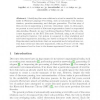Free Online Productivity Tools
i2Speak
i2Symbol
i2OCR
iTex2Img
iWeb2Print
iWeb2Shot
i2Type
iPdf2Split
iPdf2Merge
i2Bopomofo
i2Arabic
i2Style
i2Image
i2PDF
iLatex2Rtf
Sci2ools
CICLING
2010
Springer
2010
Springer
A Sequential Model for Discourse Segmentation
Identifying discourse relations in a text is essential for various tasks in Natural Language Processing, such as automatic text summarization, question-answering, and dialogue generation. The first step of this process is segmenting a text into elementary units. In this paper, we present a novel model of discourse segmentation based on sequential data labeling. Namely, we use Conditional Random Fields to train a discourse segmenter on the RST Discourse Treebank, using a set of lexical and syntactic features. Our system is compared to other statistical and rule-based segmenters, including one based on Support Vector Machines. Experimental results indicate that our sequential model outperforms current state-of-the-art discourse segmenters, with an F-score of 0.94. This performance level is close to the human agreement F-score of 0.98.
CICLING 2010 | Discourse | Discourse Segmenters | Natural Language Processing | RST Discourse Treebank |
Related Content
| Added | 18 May 2010 |
| Updated | 18 May 2010 |
| Type | Conference |
| Year | 2010 |
| Where | CICLING |
| Authors | Hugo Hernault, Danushka Bollegala, Mitsuru Ishizuka |
Comments (0)

